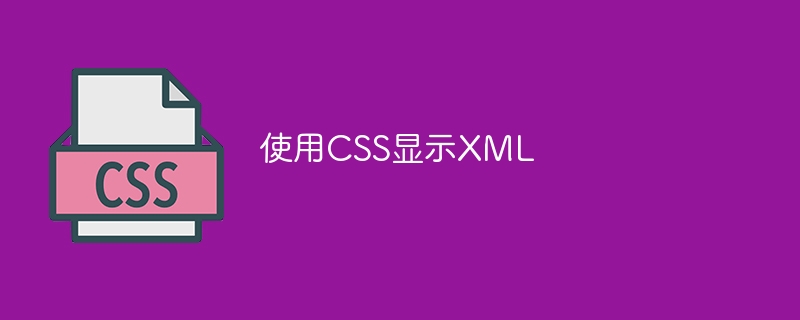

XML stands for Extensible Markup Language. It is also a markup language designed specifically for web documents. It defines a set of rules for encoding documents in a format that is both human-readable and machine-readable. It allows developers to create custom tags. XML also enables the definition, transfer, validation, and interpretation of data between applications.
We can use CSS properties to add styles to the content in XML documents. Here are the steps to display XML using CSS:
Step-1 − Create a .xml file and add your code to it.
Step-2 − Create a .css file and add styles to the tags specified in the .xml file.
Step-3 − Link the .css file to the .xml file using the following code block. This should be included in the .xml document.
<?xml-stylesheet type="text/css" href="name_of_css_file.css"?>
Step 4 - Place both files in the same folder.
Step-5 - Open the .xml file in any browser to see the CSS styles applied to the .xml element.
In the following example, we are creating an XML file that contains information about cricket player statistics and displaying the XML file using CSS.
<?xml version="1.0"?>
<style>
Cricket {
display: block;
margin-bottom: 30px;
}
name {
font-weight: bold;
color: seagreen;
}
hundreds, fifties {
color: lightslategray;
}
</style>
<Sports>
<Cricket>
<name>Virat Kohli</name>
<hundreds>75</hundreds>
<fifties>130</fifties>
</Cricket>
<Cricket>
<name>Joe Root</name>
<hundreds>46</hundreds>
<fifties>99</fifties>
</Cricket>
<Cricket>
<name>Steve Smith</name>
<hundreds>44</hundreds>
<fifties>70</fifties>
</Cricket>
<Cricket>
<name>Faf du Plessis</name>
<hundreds>23</hundreds>
<fifties>66</fifties>
</Cricket>
</Sports>Execute the "data.xml" file in any browser to see the CSS styles applied to elements in the XML file.
Following is another example to display XML file using CSS −
Save the following file as "data.xml" −
<?xml version="1.0" encoding="UTF-8"?>
<?xml-stylesheet type="text/css" href="style.css"?>
<root>
<person>
<name>Maya</name>
<age>30</age>
<gender>Female</gender>
</person>
<person>
<name>Ram</name>
<age>25</age>
<gender>Male</gender>
</person>
<person>
<name>Varun</name>
<age>25</age>
<gender>Male</gender>
</person>
<person>
<name>Sarah</name>
<age>25</age>
<gender>Female</gender>
</person>
</root>
Save the following file as "style.css" −
root {
display: block;
font-family: Arial, sans-serif;
font-size: 14px;
margin-bottom: 20px;
}
person {
display: block;
width: 10%;
display: block;
margin-bottom: 20px;
border: 1px solid black;
padding: 10px;
border-radius: 5px;
}
name {
font-weight: bold;
color: #333;
}
age {
color: #999;
}
gender{
color: brown;
font-weight: bolder;
}
<?xml version="1.0" encoding="UTF-8"?>
<style>
root {
display: block;
font-family: Arial, sans-serif;
font-size: 14px;
margin-bottom: 20px;
}
person {
display: block;
width: 10%;
display: block;
margin-bottom: 20px;
border: 1px solid black;
padding: 10px;
border-radius: 5px;
}
name {
font-weight: bold;
color: #333;
}
age {
color: #999;
}
gender{
color: brown;
font-weight: bolder;
}
</style>
<root>
<person>
<name>Maya</name>
<age>30</age>
<gender>Female</gender>
</person>
<person>
<name>Ram</name>
<age>25</age>
<gender>Male</gender>
</person>
<person>
<name>Varun</name>
<age>25</age>
<gender>Male</gender>
</person>
<person>
<name>Sarah</name>
<age>25</age>
<gender>Female</gender>
</person>
</root>Execute the "data.xml" file in any browser to view stylings applied on XML file elements.
The above is the detailed content of Display XML using CSS. For more information, please follow other related articles on the PHP Chinese website!




